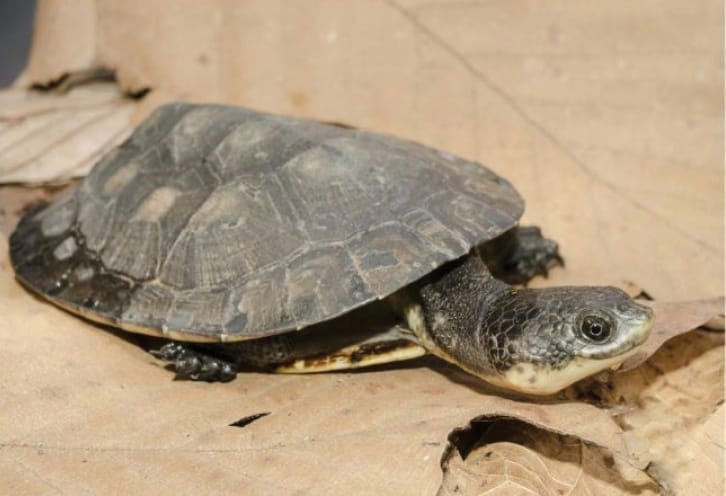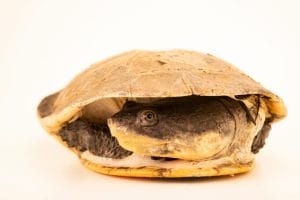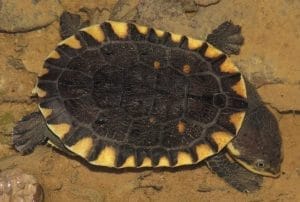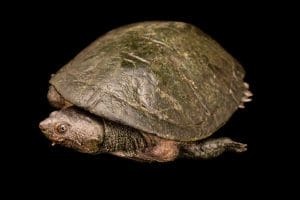Mesoclemmys gibba (gibba turtle)
Home > Turtle Database > Mesoclemmys gibba (gibba turtle)
Mesoclemmys gibba, commonly known as the gibba turtle, is a freshwater species native to South America. Known for its distinctive shell and adaptable nature, this turtle plays a vital role in its ecosystem.
Native To These Regions
Amazon (Ecuador), Amazonas (Brazil), Amazonas (Venezuela), Bolívar (Venezuela), Bolivia, Colombia, French Guiana, Guyana, Pará (Brazil), Peru, Roraima (Brazil), SurinameNative Turtle Species Map – Find Turtles by Region
Scientific Classification
- Kingdom: Animalia
- Phylum: Chordata
- Class: Reptilia
- Order: Testudines
- Family: Chelidae
- Genus: Mesoclemmys
- Species: Mesoclemmys gibba
Common Names
- Gibba Turtle
- Gibba Side-Necked Turtle
This Hilarious Turtle Book Might Know Your Pet Better Than You Do
Let’s be real—most turtle care guides feel like reading a textbook written by a sleep-deprived zookeeper.
This one’s not that.
Told from the snarky point of view of a grumpy, judgmental turtle, 21 Turtle Truths You’ll Never Read in a Care Guide is packed with sarcasm, sass, and surprisingly useful insights.
And hey—you don’t have to commit to the whole thing just yet.
Grab 2 free truths from the ebook and get a taste of what your turtle really thinks about your setup, your food choices, and that weird plastic palm tree.
It’s funny, it’s honest, and if you’ve ever owned a turtle who glares at you like you’re the problem—you’ll feel seen.
Identification
Description
Mesoclemmys gibba is a medium-sized freshwater turtle with a domed carapace, typically brown to olive in color. Its shell often features patterns that provide effective camouflage in natural habitats. The turtle has a slightly upturned shell and webbed feet, which are well-adapted for an aquatic lifestyle.
Sexual Dimorphism
Males are generally smaller than females and possess longer, thicker tails. Additionally, males exhibit more vivid coloration on their plastron and may have more pronounced markings compared to females.
Check more turtles from the Mesoclemmys genus
Native Origin and Distribution
Geographical Range
Mesoclemmys gibba is native to South America, with its range extending across countries such as Brazil, Bolivia, Peru, and Paraguay. It is commonly found in regions surrounding the Amazon Basin and other freshwater systems within tropical rainforest areas.
Preferred Habitat
Gibba turtles prefer slow-moving freshwater environments, including ponds, marshes, rivers, and swamps. These habitats typically have abundant vegetation, which provides both shelter and foraging opportunities.
Behavior
Feeding Habits
Gibba turtles are omnivorous, feeding on a varied diet that includes aquatic plants, insects, small invertebrates, and occasionally small fish. They forage both in water and on land, utilizing their webbed feet to navigate their environment efficiently.
Predators
Their natural predators include larger fish, birds of prey, and mammals that can access aquatic environments. Juvenile gibba turtles are particularly vulnerable to predation by a wider range of animals.
Reproduction
Breeding Season
Breeding typically occurs during the rainy season when rising water levels create optimal conditions for nesting and increase the chances of juvenile survival.
Reproductive Method
Mesoclemmys gibba is oviparous, laying eggs in nests dug into sandy or soft soil near water bodies. Females may lay multiple clutches per breeding season, with each clutch containing several eggs.
Conservation
Extinction Status
Mesoclemmys gibba is currently listed as Least Concern by the IUCN. However, certain populations may be experiencing declines due to various threats.
Threats
The primary threats to gibba turtles include habitat destruction from deforestation, pollution of water bodies, and collection for the pet trade and consumption.
Conservation Measures
Conservation efforts focus on protecting natural habitats, regulating the collection and trade of gibba turtles, and implementing breeding programs in captivity to help maintain stable populations.
Economic Importance
While not a major economic species, gibba turtles are harvested locally for their meat and shells. Additionally, they hold value in the pet trade and contribute to ecotourism by enhancing the biodiversity of their natural habitats.
Interesting Facts
- Mesoclemmys gibba is a side-necked turtle, meaning it folds its neck sideways under the shell rather than retracting it straight back.
- They possess a strong ability to camouflage, which helps protect them from predators.
- This species is highly adaptable to various freshwater environments, contributing to its wide distribution across South America.

About Author
Muntaseer Rahman started keeping pet turtles back in 2013. He also owns the largest Turtle & Tortoise Facebook community in Bangladesh. These days he is mostly active on Facebook.















